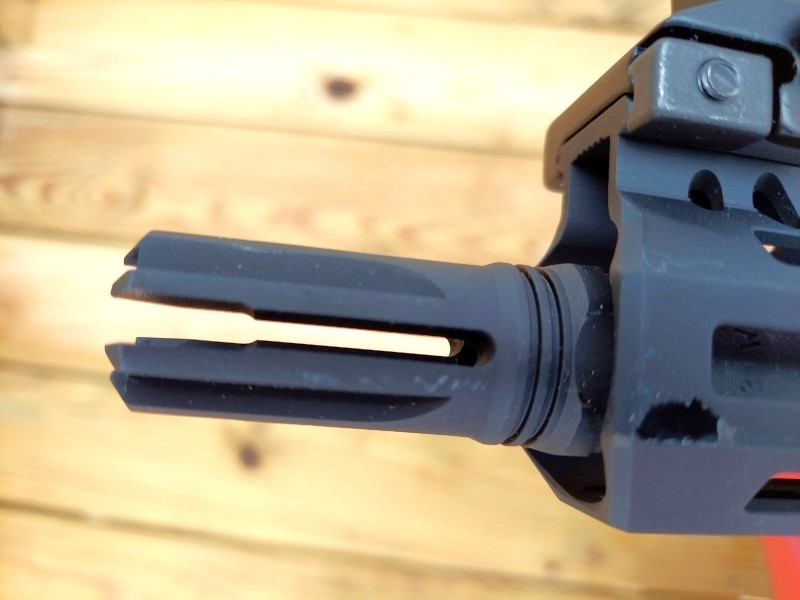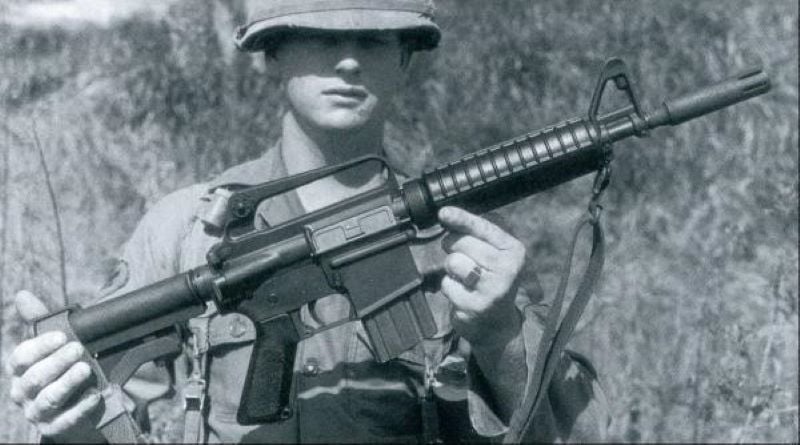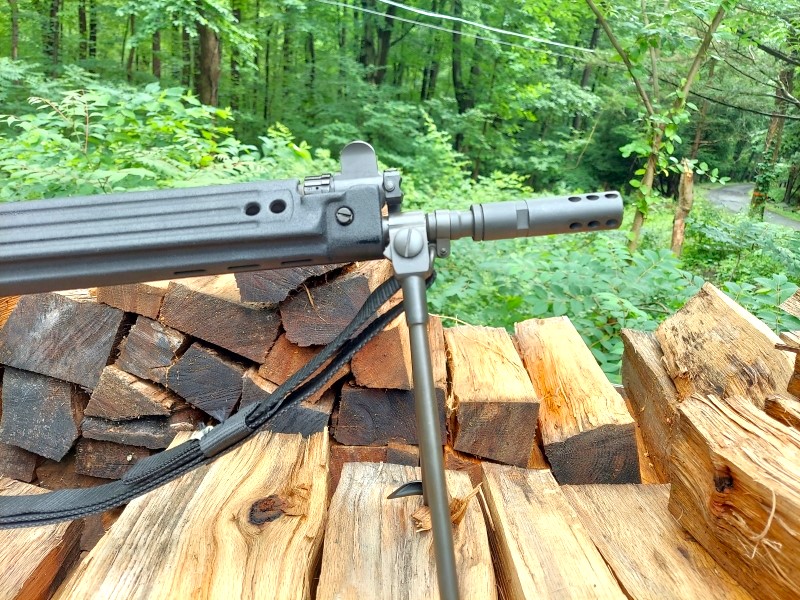“Mine is shorter than yours,” said no guy ever. Well, except for those of us in the gun culture who have an affinity for short barrels. What’s the deal with muzzle devices? Why would they be pinned and welded to a barrel? I’m going to tell you why!
Why Shorties
Why do people like short barrels? There are a couple of reasons.
First, they’re just cool. They look a bit different than firearms with standard-length barrels, and many of us tend to gravitate toward different and unique things. Handiness is another factor. Rifles with shorter barrels handle better in close quarters. When moving through rooms and other confined spaces, such as vehicles, they simply work better. Another positive aspect of shorter barrels is that they allow the firearm to be stored in a compact space more easily.
Which Platforms?
Normally, when I think of short-barrel firearms equipped with muzzle devices, I picture two main types of firearms: the AK-47 and AR-15 platforms. Naturally, there are others, but those two are eminently popular. A few others that spring to mind are the M1A (models such as the Scout Squad Rifle or SOCOM), FAL (Para FAL), and Galil. That said, I’m certain I’m forgetting probably a dozen other platforms. For muzzle devices, they can be either flash suppressors or muzzle brakes.
Why Pinned And Welded Muzzle Devices?
Why would a muzzle device be pinned and welded? Wouldn’t it be better to have the device screwed on so we can remove or change it if we desire?
Yes, the option of removing the device is most desirable. However, some rifles are a little under the legal limit of 16 inches. A 16-inch limit? Yes, under federal law, a rifle must have at least a 16-inch barrel length. Anything less than 16 inches must be registered with the ATF as a Short-Barreled Rifle (SBR). Along with that registration comes a $200 tax, lots and lots of red tape, and a waiting period until it is approved. For those reasons, many people elect not to go through the hassle. Plus, the SBR can only be sold to another person with a tax stamp.
A viable option to avoid all that hassle is to take a barrel shorter than 16 inches and permanently attach a muzzle device to it that brings the overall length up to at least 16 inches. Let’s say the barrel is 14.5 inches long. A permanently attached muzzle device of 1.5 inches brings the grand total up to 16 inches. This is often done with certain AR-15s, specifically ones with 14.5-inch M4-type barrels. Permanently attaching a muzzle device brings the rifle into compliance and avoids all that paperwork.
What Is Pinning And Welding?
In very simple terms, a hole is drilled into the muzzle device (if it doesn’t already come with one), and a pin is driven into the hole so it cannot come off the barrel threads. The pin is then welded into place, permanently attaching the muzzle device.
Some Devices
Not all the muzzle devices discussed here are pinned and welded; rather, we’ll give a broader look at what we can hang on the end of the barrel. Some are flash hiders, while others are muzzle brakes.
AR Pistol
This device was installed on an AR-15 pistol with a 7.5-inch barrel. Since it’s mounted on a pistol, there is no effort to raise that to 16 inches. Rather, flash suppression was the main goal for using this muzzle device, and this one does a very nice job of suppressing flash.

This muzzle device is a Strike Industries Venom. It has four prongs that break up and spread the flash out pretty efficiently. This particular device is not pinned and welded since it’s on a pistol and not a rifle. Nevertheless, it’s a viable option for pinned and welded purposes.
M1A
Springfield Armory has a few shortened iterations of its classic M1A rifle. The SOCOM 16, which includes a 16.25-inch barrel and composite collapsible stock, springs to mind. There is a similarly sized M1A, the “Tanker” model, with the same barrel length and a classic walnut stock. Another option is the Scout Squad Rifle with composite or walnut stock and an 18-inch barrel.

These rifles don’t need a pinned and welded muzzle device to reach legal length. However, each sports an extremely efficient muzzle brake to keep muzzle rise to a minimum.
I can personally tell you that the Scout Squad rifle’s muzzle brake is incredibly effective at keeping muzzle rise and recoil down. You don’t realize you’re shooting a .308—aside from the muzzle blast. The 18-inch barrel with muzzle brake produces a ferocious muzzle blast that demands the best hearing protection. I normally use both earplugs and muffs when shooting it.
CAR-15/AR-15
Although it’s fallen out of favor for more modern AR designs, the old CAR-15 (Colt Automatic Rifle) featured a 10.5 or 11.5-inch barrel. A 5.5-inch flash suppressor was permanently attached, bringing the little carbine up to legal length for civilian use without the need for a tax stamp. Of course, military versions didn’t have to contend with Federal law. Ironically, the ATF classified the original flash suppressor as a sound suppressor! Despite the fact it emitted a massive fireball and ferocious muzzle blast, they still said it reduced the sound enough to be considered a sound suppressor.

The flash suppressor was ultimately redesigned for general civilian use to comply with the ATF’s requirements. These days, a few companies have brought back the CAR-15 in a retro version popular with civilian shooters.
As mentioned earlier, some AR-15s (sometimes referred to as “M-4geries”) have a 14.5-inch barrel just like their military counterparts. The addition of a pinned and welded muzzle device brings the barrel length up to just over 16 inches. This makes them legal for ownership without a tax stamp.
As a matter of note, some sub-16-inch barrel ARs have an AK-74 type muzzle brake permanently attached to lengthen the barrel.
Para FAL
DS Arms has made a number of FAL variations over the years. Each one has some type of muzzle device affixed to the end of the barrel. Recently, I examined a Para FAL from DSA, and the rifle was exquisite.

This particular rifle’s barrel is 14 inches long, and the pinned and welded muzzle brake brings it to just over the 16-inch requirement. Overall, this muzzle brake effectively reduces muzzle rise and gives the rifle enough barrel length.
AK-47
There are a number of muzzle devices for the AK-47 platform that have come about over the years. One of the most recognizable originated on the AK-74. It’s long and features an open space (a chamber) near the end. It’s also been adapted for the AK-47, and has been used on other rifles, such as the AR-15, to lengthen barrels so they reach legal limits.

The Down Side to Pinned and Welded
So far, it’s all gumdrops and roses, right? Not so fast. Let’s look at the down side to a pinned and welded muzzle device.
What if you want to modify the barrel, try a different muzzle brake or flash suppressor, or run a sound suppressor? That’s not going to be a walk in the park because you have a permanently attached muzzle device.
To remove the device, the welded pin has to be drilled out without ruining the barrel threads. It’s difficult to do without damaging the barrel because it’s easy to go a little too far when drilling the pin, which then drills right into the barrel threads. At that point, the barrel is basically garbage. On the other hand, if you never plan on changing the rifle or muzzle device, maybe the pinned and welded option is a good one for you.
In Conclusion
Before you pin and weld a muzzle device onto your rifle, it’s a good idea to consider whether you might want to change it down the road. Ask yourself what you’re trying to accomplish. Is it really worth it to have a slightly shorter barrel and go through the trouble of pinning/welding? Or, might it be better to go with a 16-inch (or longer) barrel and give yourself the freedom to change things down the road?
I’ve given you a few examples of pinned and welded barrels and other muzzle devices that don’t need to be pinned and welded. Both options produce a pretty cool look. Good luck with your decision!


